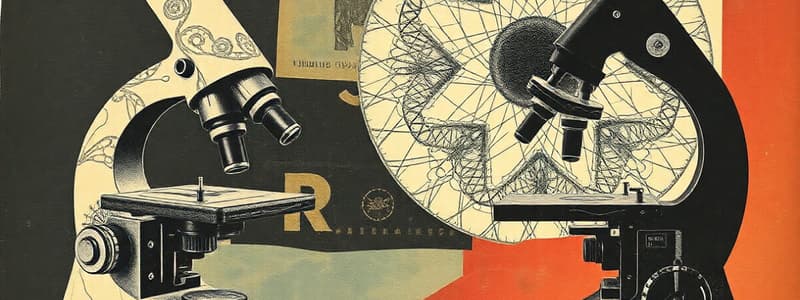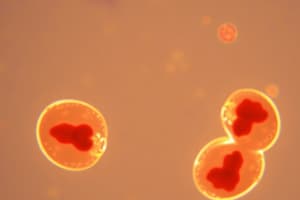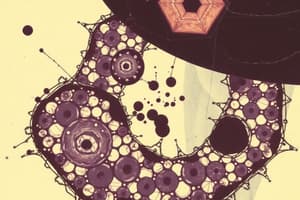Podcast
Questions and Answers
What is the primary function of mitochondria in a cell?
What is the primary function of mitochondria in a cell?
- Digestion of cell matter
- Synthesis of ribosomes
- Production of energy (correct)
- Storage of proteins
During which stage of mitosis do chromosomes line up in the middle of the cell?
During which stage of mitosis do chromosomes line up in the middle of the cell?
- Anaphase
- Metaphase (correct)
- Prophase
- Telophase
Which organelle is responsible for breaking down or digesting cell matter?
Which organelle is responsible for breaking down or digesting cell matter?
- Golgi body
- Ribosome
- Lysosome (correct)
- Chloroplast
What is the unique characteristic of stem cells?
What is the unique characteristic of stem cells?
Which of the following organelles is found only in plant cells?
Which of the following organelles is found only in plant cells?
What role do spindle fibers play during mitosis?
What role do spindle fibers play during mitosis?
How many total chromosomes do human body cells contain?
How many total chromosomes do human body cells contain?
Which type of cell is responsible for carrying oxygen in the human body?
Which type of cell is responsible for carrying oxygen in the human body?
What type of images are produced by convex mirrors?
What type of images are produced by convex mirrors?
What is the formula for magnification in terms of image height and object height?
What is the formula for magnification in terms of image height and object height?
Which of the following phenomena is an example of refraction?
Which of the following phenomena is an example of refraction?
When does total internal reflection occur?
When does total internal reflection occur?
What determines the index of refraction in a medium?
What determines the index of refraction in a medium?
Which lens type causes light rays to converge?
Which lens type causes light rays to converge?
What is the primary function of a concave mirror?
What is the primary function of a concave mirror?
In Snell's law, what does n represent?
In Snell's law, what does n represent?
What is a property of light that describes its behavior as a wave?
What is a property of light that describes its behavior as a wave?
Which of the following indicators turns pink in a basic solution?
Which of the following indicators turns pink in a basic solution?
How do acids generally exhibit their chemical properties?
How do acids generally exhibit their chemical properties?
If light travels at $3 x 10^8$ m/s in a vacuum, what is its speed in km/h?
If light travels at $3 x 10^8$ m/s in a vacuum, what is its speed in km/h?
What are the primary colors in the additive color theory?
What are the primary colors in the additive color theory?
Which color is NOT a primary color in the subtractive color model?
Which color is NOT a primary color in the subtractive color model?
Which of the following describes the behavior of light in terms of how it travels?
Which of the following describes the behavior of light in terms of how it travels?
What is the definition of a light year?
What is the definition of a light year?
What is the primary function of arteries in the circulatory system?
What is the primary function of arteries in the circulatory system?
Which of the following best describes a positive ion?
Which of the following best describes a positive ion?
What determines the chemical formula of a molecular compound?
What determines the chemical formula of a molecular compound?
In the process of egestion, what is primarily occurring?
In the process of egestion, what is primarily occurring?
What is the role of the electric nodes in the heart?
What is the role of the electric nodes in the heart?
Which element in the chemical formula NaCl represents the metal?
Which element in the chemical formula NaCl represents the metal?
What is a common characteristic of capillaries?
What is a common characteristic of capillaries?
What does the law of conservation of mass state?
What does the law of conservation of mass state?
During which type of chemical reaction does a compound break down into simpler substances?
During which type of chemical reaction does a compound break down into simpler substances?
Which structure is the last part of the respiratory pathway before oxygen enters the bloodstream?
Which structure is the last part of the respiratory pathway before oxygen enters the bloodstream?
Flashcards
Compound Light Microscope
Compound Light Microscope
A type of microscope that uses light to magnify objects. It's commonly used in classrooms and labs.
Electron Microscope
Electron Microscope
A type of microscope that uses electrons to magnify objects. It can see things too small for light microscopes, like viruses.
Scanning Electron Microscope
Scanning Electron Microscope
A type of electron microscope that creates three-dimensional images. Useful for analyzing surface structures of objects.
Mitosis
Mitosis
Signup and view all the flashcards
Metaphase
Metaphase
Signup and view all the flashcards
Telophase
Telophase
Signup and view all the flashcards
Prophase
Prophase
Signup and view all the flashcards
Anaphase
Anaphase
Signup and view all the flashcards
Chemical Digestion
Chemical Digestion
Signup and view all the flashcards
Circulatory System
Circulatory System
Signup and view all the flashcards
Blood Flow Pathway
Blood Flow Pathway
Signup and view all the flashcards
Arteries
Arteries
Signup and view all the flashcards
Capillaries
Capillaries
Signup and view all the flashcards
Veins
Veins
Signup and view all the flashcards
Atomic Structure
Atomic Structure
Signup and view all the flashcards
Ion
Ion
Signup and view all the flashcards
Ionic Bond
Ionic Bond
Signup and view all the flashcards
Molecular Bond
Molecular Bond
Signup and view all the flashcards
Chemical Reaction: Rearrangement
Chemical Reaction: Rearrangement
Signup and view all the flashcards
Balancing Chemical Equations
Balancing Chemical Equations
Signup and view all the flashcards
pH Scale
pH Scale
Signup and view all the flashcards
Phenolphthalein
Phenolphthalein
Signup and view all the flashcards
Litmus Paper
Litmus Paper
Signup and view all the flashcards
Light as a Transverse Wave
Light as a Transverse Wave
Signup and view all the flashcards
Wave-Particle Duality of Light
Wave-Particle Duality of Light
Signup and view all the flashcards
Light Year
Light Year
Signup and view all the flashcards
Reflection
Reflection
Signup and view all the flashcards
Regular Reflection
Regular Reflection
Signup and view all the flashcards
Diffuse Reflection
Diffuse Reflection
Signup and view all the flashcards
Law of Reflection
Law of Reflection
Signup and view all the flashcards
Concave Mirror
Concave Mirror
Signup and view all the flashcards
Convex Mirror
Convex Mirror
Signup and view all the flashcards
Refraction
Refraction
Signup and view all the flashcards
Index of Refraction
Index of Refraction
Signup and view all the flashcards
Study Notes
Grade 10 Biology Exam Review
- Microscopes:
- Compound light microscope is used in class
- Electron microscopes are more powerful, used for small objects
- Scanning electron microscope is used for 3D objects
- Parts of a compound light microscope (structure and function)
- Organelle functions (diagrammed)
- Cells including animal and plant cells labeled with organelle names
- Mitochondria: energy production in cells
- Lysosomes: break down cell matter
- Golgi bodies: store proteins
- Ribosomes: make proteins
- Plant cell organelles: chloroplasts, cell walls, large vacuoles
- Mitosis:
- Interphase: normal cellular functions (e.g., growth, DNA replication)
- Prophase: DNA thickens & chromosomes become visible, pairing up
- Metaphase: chromosomes line up in the middle of the cell
- Anaphase: chromosomes separate and move to opposite sides
- Telophase: nuclear membrane re-forms, cytoplasm divides, forming 2 daughter cells
- Spindle fibers: role in pulling chromosomes apart
- Human cell chromosomes: 46 total (2 copies of each chromosome)
- Cell types:
- Nerve cells: carry electrical signals
- Red blood cells: carry oxygen
- Cardiac muscle: heart muscle (beats)
- Smooth muscle: involuntary muscle movement (controllable)
- Stem cells: unspecialized cells, differentiate to become other cell types
- Cell Types Uses:
- Stem cells can become multiple different types of cells in the body
- Ethical concerns arise from using stem cells
Body Systems
- Digestive system:
- Structures and enzymes (discussed)
- Mechanical vs. chemical digestion
- Ingestion, digestion, absorption, egestion
Chemistry
Structure of an Atom
- Particle Type: Proton (+1, in nucleus, 1 amu), Neutron (0, in nucleus, 1 amu), Electron (-1, circling nucleus, 0 amu)
- Bohr Diagrams: Atoms have the same number of protons and electrons (uncharged)
- Ions: Atoms that have lost or gained electrons (atoms with a charge)
- Ionic compounds: metal and non-metal atoms join due to ionic bond
Chemical Reactions
- Synthesis: A + B → AB
- Decomposition: AB → A + B
- Single Displacement: A + BC → AC + B
- Double Displacement: AB + CD → AD + CB
- Combustion: Complete and Incomplete
- Law of Mass Conservation: Reactions do not create or destroy matter
- Balancing chemical equations: preserving overall mass
Acids and Bases
- Acids: Taste sour, start with Hydrogen, on pH scale
- Bases: Taste bitter, feel slippery, end in OH, on pH scale
- pH scale: Measure of how acidic or basic a substance is.
Light and Optics
- Properties of Light: Travels as a transverse wave, wave-particle duality, travels in straight lines, a disturbance of electric and magnetic fields
- Wave Equation: v = fλ (wave speed = frequency × wavelength).
- Electromagnetic Spectrum and Visible Light: ROYGBIV (Red, Orange, Yellow, Green, Blue, Indigo, Violet).
- Color Theory: Additive and subtractive color mixing and application
Reflection and Refraction
- Reflection: Regular and diffuse reflection, law of reflection
- Refraction: Change in light speed at a boundary (interface of 2 materials), Phenomena that arise due to refraction.
- Mirrors: Concave (converging), Convex (diverging), characteristics of images generated from mirrors
- Lenses: Converging (convex), Diverging (concave), ray diagrams of lenses, use of lenses in technology, the human eye, near-sightedness, farsightedness
- Thin Lens Equations: 1/f = 1/do + 1/di
Studying That Suits You
Use AI to generate personalized quizzes and flashcards to suit your learning preferences.




